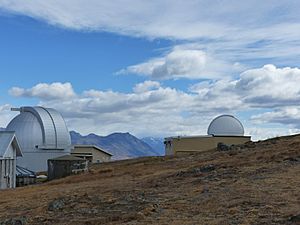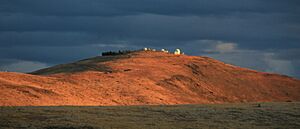Mount John University Observatory facts for kids
Quick facts for kids University of Canterbury Mt John Observatory (UCMJO) |
|||||||||||||
|---|---|---|---|---|---|---|---|---|---|---|---|---|---|

UC Mount John Observatory at the top of Mount John
|
|||||||||||||
| Organization | University of Canterbury | ||||||||||||
| Code | 474 | ||||||||||||
| Location | Mount John, South Island, New Zealand | ||||||||||||
|
Coordinates
|
43°59.2′S 170°27.9′E / 43.9867°S 170.4650°E
|
||||||||||||
| Altitude | 1,029 metres (3,376 ft) | ||||||||||||
| Weather | 20% of nights photometric | ||||||||||||
| Established | 1965 | ||||||||||||
|
|||||||||||||
The University of Canterbury Mount John Observatory (UCMJO) is New Zealand's main place for studying space. It sits high up on Mount John, about 1,029 metres (3,376 ft) above sea level. This special place is in the South Island of New Zealand. It was built in 1965.
Many telescopes are here, including a big 1.8-meter MOA Telescope. The closest town is Lake Tekapo, which is quite small. About 20% of nights are clear enough for 'photometry'. This means they can measure the brightness of stars. Many more nights are good for other types of space study.
The University of Canterbury runs the UCMJO. It is home to HERCULES, a powerful tool for analyzing starlight. It also works with the MOA project, a team from Japan and New Zealand. This team looks for planets using a special method. A large 1.8-meter telescope was built for the MOA Project.
In 2012, the area around the observatory became a special "Dark Sky Reserve". This means the sky is kept very dark at night. It helps astronomers see the stars clearly. This reserve is one of only four like it in the world. The sky here is very dark, almost perfect for stargazing.
Contents
Discover the Telescopes at Mount John
There are five large telescopes on the mountain. They are used regularly for research. There is also a cafe and night tours for visitors. These tours are run by a company called Earth and Sky. Scientists who visit can stay in accommodation on the mountain. A superintendent lives there to manage everything.
The MOA Telescope
This telescope opened in December 2004. Japanese astronomers built it for the MOA project. It is a 1.8-meter telescope. It is the largest telescope in New Zealand. It helps scientists find planets far away.
The McLellan Telescope
This is a 1.0-meter reflecting telescope. It can be used for taking pictures of stars. It also sends light through a fiber-optic cable to a special tool called HERCULES. This tool helps scientists study the light from stars.
The McLellan Telescope is named after Professor Alister George McLellan. He was a key person in setting up the observatory. He was its first Director when it opened in 1965.
The Boller & Chivens Telescope
This telescope is 0.61 meters wide. It is used for measuring the brightness of stars. It uses a special camera called an Apogee Alta CCD camera.
The Optical Craftsmen Telescope
This is another 0.61-meter telescope. It is used only for measuring star brightness. It is being updated to work robotically. This means it can be controlled from far away. It is the first telescope in the Southern Hemisphere for the AAVSO. The AAVSO is a group that studies variable stars.
The Earth and Sky Telescope
This telescope is 0.4 meters wide. It is used only for tourist visits. People on night tours use it to look at the stars.
Amazing Discoveries from Mount John
In 2008, scientists at the observatory made an exciting discovery. Using their MOA-II telescope, they found a very small planet. This planet was outside our Solar System. It was only 3.3 times bigger than Earth. It orbits a small star about 3,000 light-years away. Scientists think this planet might have a thick atmosphere. It could even have a liquid ocean on its surface!
Images for kids




